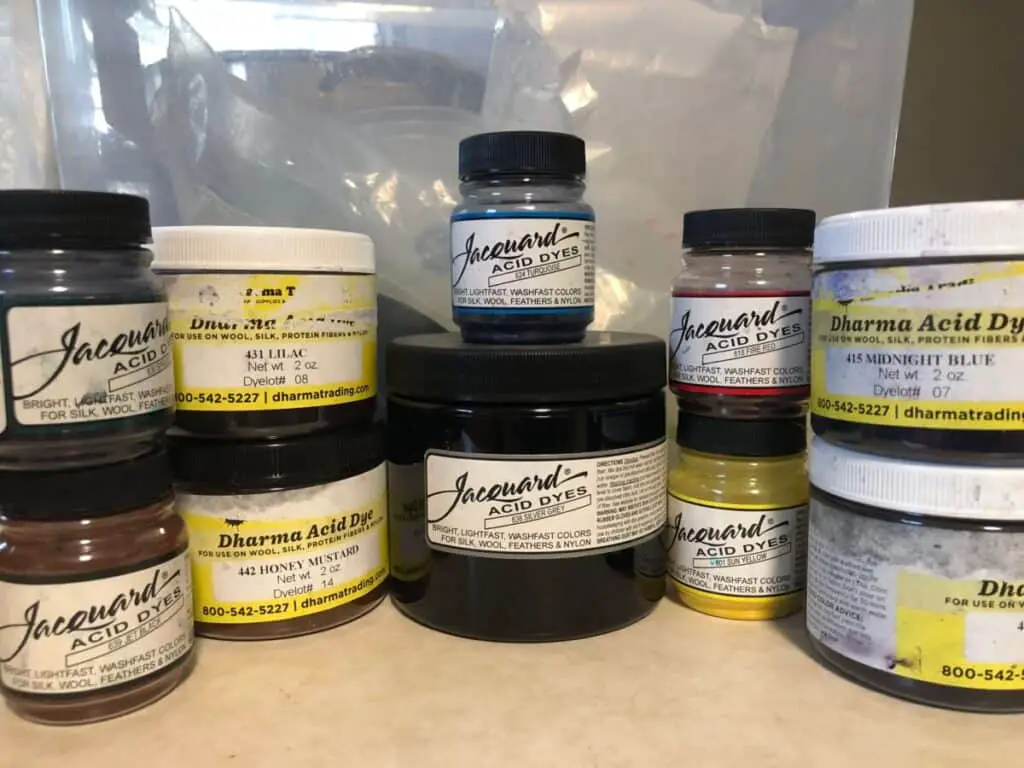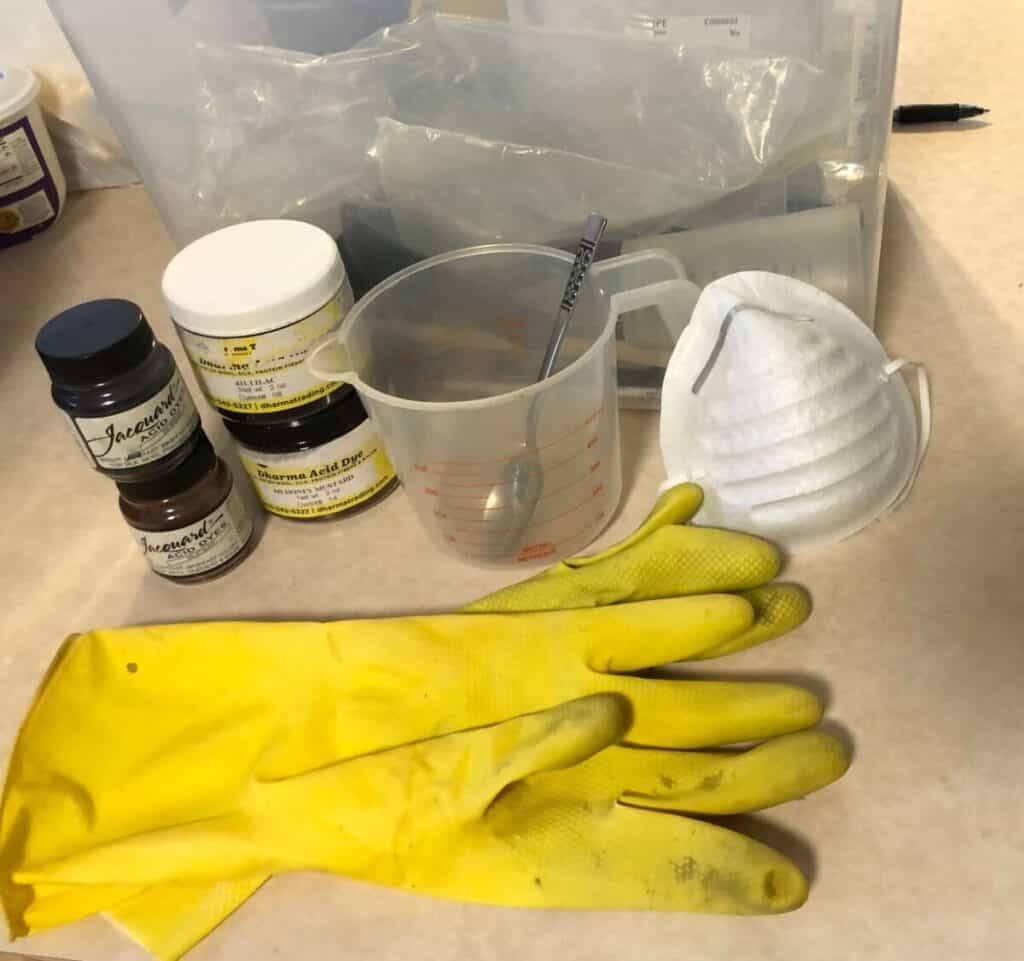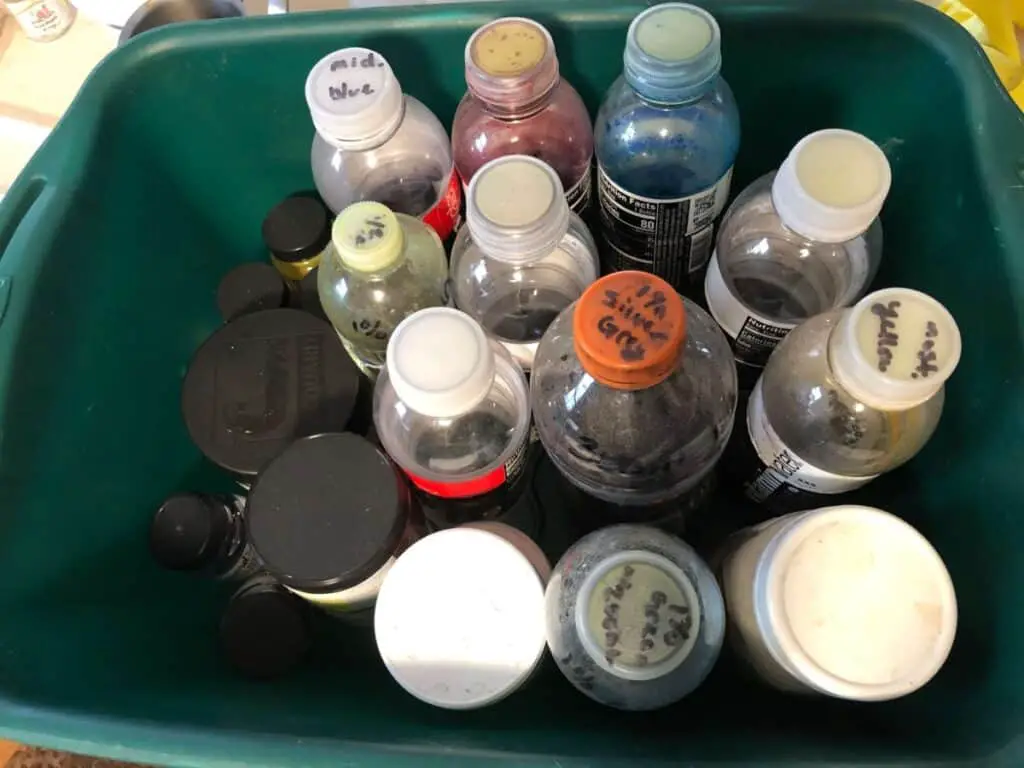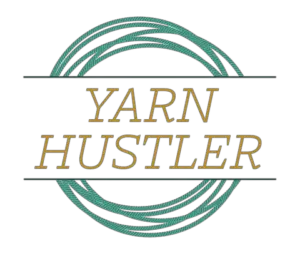When you get into fiber arts, one of the most fun things to do is to play around with color. So, obviously, you’ll want to get into dyeing. Researching dyes might lead you to the question: are acid dyes toxic?
Acid dyes are not harmful if touched, but dye should never be inhaled or ingested. For this reason, you should wear a mask when using powdered dyes, have dye-specific dishes, and don’t handle powdered dye where you also cook food.
This may seem like a lot of work, but trust me it’s worth it. We’ll go over some easy ways to do these things, as well as how to dye safely even if you might not have very much space available.
Table of Contents
Are Acid Dyes Toxic?

Because they’re called acid dyes, a lot of people think that means that the dye itself is acidic. But, that’s actually not true at all. The reason they are called acid dyes is that a very mild acid (like vinegar) is required to complete the dyeing process.
Now, that doesn’t mean you should take acid dyes lightly, there are still some safety things to consider when using acid dyes.
Most acid dyes are sold in powdered form. The powder can cause irritation to the respiratory tract if inhaled and cause irritation to the eyes and skin if the powder comes in contact with them.
For this reason, you should always wear a pair of gloves and some kind of mask that covers your mouth and nose when using the powdered form. I also recommend wearing some kind of eye protection and working in a well-ventilated area.
This powder also has a habit of coating the surface you’re working on, no matter how hard you try to keep it from happening. And, since you shouldn’t eat the dye, you’ll want to make sure you don’t dye somewhere that you also cook food or use the same utensils for dyeing and cooking.
Once you mix your powdered dyes into a liquid form or if you are using a liquid dye, you don’t have to worry about inhaling the powder. The only way acid dyes can be toxic in liquid form is if they get in your eyes or they’re ingested.
I think you’re all smart enough to know not to drink the dye, but you should still keep your dyestuff out of reach of children and pets to keep them safe.
The last thing you should do when using dyes, either powdered or liquid, is to wear gloves. The dye isn’t toxic through skin contact but it could cause some skin irritation. It will also stain your hands colors for days, which probably isn’t something you want.
Now that we’ve gone over some of the boring safety information, let’s talk a little bit about how to have fun with acid dyes and still stay safe.
How To Use Acid Dyes Safely

I know that was a lot of information and safety things to consider, but I promise you can still make beautiful, colorful, creations safely from your own home.
I know, crazy right? We all really want to have our own dye studio with all the colors lined up and ready for use, but sadly, that’s not reasonable for most of us. So, let’s see what kind of at-home dye studio we can make for ourselves.
Dye Studio Space
For a dye studio space, we’re looking for a well-ventilated area with some table space that isn’t in the kitchen.
Why not in the kitchen? Well, if you remember, the powdered dye has a habit of getting on everything and you don’t want it to get on the kitchen appliances that you’ll later use to cook food.
In order to keep your space clean if you’re using a table you use for other things too, go buy a couple of cheap plastic, dollar store, table clothes. Put one on the table, and one on the floor. It’ll make cleaning up super easy and your table and carpet will thank you for it.
Second, for acid dyes, we’ll need a heat source. This could be a stove, hot plate, microwave, oven, or even the sun.
If you have the means to have both a well-ventilated area and a heat source in the same room that’s great (remember, no mixing powdered dye in the kitchen). But, you might have to separate it into two different areas, a dye mixing area, and a dyeing area.
See what I did there? If not, that’s okay, I’ll explain.
The reason you can’t use your kitchen is that you don’t want the powdered dye all over the things you’ll cook and eat with. But, if you mix your powdered dye into liquid form somewhere else, you can then use your kitchen stove as the heat source.
Clever, right? The only thing to still keep in mind if you use this method is to make sure you have dye-specific utensils and dishes. No using your favorite pot for dyeing and then for making spaghetti later.
I’ve talked a lot about making liquid dye, so let’s dig into what I mean and how to do it.
Creating Liquid Dye Stock Solutions
Most acid dyes come in powdered form, but some brands, like RIT, come premixed. If you only use liquid dyes, you can skip this section and move on to dye storage.
But, if you use powdered dyes, or you’re just curious, stick around. I’ll tell you how to mix dyes and how to keep your dye contained in one area.
First, we need to talk about mixing dye stock solutions. If you’re a visual person and reading words on a page won’t do it for you, here’s a great video all about dye stock solutions and how to mix dyes.
There’s a lot of good information in that video about how to mix dye solutions, but I’ll give you some highlights if you don’t want to watch the whole thing.
First, make sure you’re mixing in a well-ventilated area and you have your area covered so you won’t stain anything with dye. Next, make sure you’ve got all your safety gear: mask, gloves, and eye protection.
Now, you get to do the fun stuff. Pick your first color.
Usually, dye stock solutions are made in a 1% solution. This just means you have 1 gram of dye for every 100 mL of liquid.
If you don’t have a fancy scale to measure out the exact number of grams you need, don’t worry, I got you. A teaspoon of dye is about 4 grams.
Keep in mind, this isn’t a perfect conversion. But, if you’re just getting into dyeing and don’t want to buy a scale, this will be good enough to try some dye experiments with.
Once you’ve got your dye, you’ll need hot water, borderline boiling water. This is important, a lot of dyes won’t dissolve correctly in water unless it’s at a higher temperature. So, to make sure you cover all your bases, just start with super hot water.
Alright, you’ve got your dye, you’ve got your water, now what? Well, you mix them obviously!
But, you should mix them in a specific way, here’s how. For the purposes of this example, we’ll say you’re mixing a teaspoon of dye with 400 mL of hot water.
Take your teaspoon of dye and put it in something that you can stir in, I use small plastic cups. Then, pour just a splash of your hot water into the cup with your dye.
Now, stir the dye and water together until the powder is dissolved in the water. If you didn’t add enough water at first and end up with a paste, that’s okay, that actually makes the mixing easier. Just add a little more hot water until it’s fully dissolved.
Next, add the rest of your hot water little by little while still stirring. And voila! You have successfully made your first batch of dye. Easy peasy!
But, now what do you do with it? Well, you can either use it right away if you have a project in mind, or you can put it away in storage for a later date.
Dye Storage

Whether you’re wanting to store a dye batch, powdered dye, or some leftover dye stock, let’s talk about how to best store your dyes.
First, let’s talk about powdered dyes. For the most part, you don’t need to do much with your powdered dyes, they already come in pretty good containers. But, here are some things to keep in mind.
Because powdered dyes need water to be mixed, you’ll want to make sure you store your powdered dyes in a dry place so they don’t get mixed with water before you want them to.
You’ll also want to make sure you keep them out of reach of kids and pets. I keep all my powdered dyes in a sealable Rubbermaid container, this also helps keep moisture out.
After you mix up your powdered dyes, what do you do with your dye stock solutions? Well, as with anything, there are a few different things you can do with it. You’ll want a tight-sealing container so the dye doesn’t leak out.
It can be glass or plastic. Honestly, I recycle old plastic water bottles from Gatorade and Vitamin Water, they work great! The most important thing about storing dye stock solutions is labeling.
Make sure you clearly label what color you have in that container as well as what percent dye stock solution it is. Mine usually looks something like “Mustard Yellow 1%”.
You’ll probably want to put this label on some masking tape so you can reuse containers for different colors once you empty them out. I didn’t do that with some of my containers and I regret it.
These storage guidelines can be used for any leftover dye stock as well.
Then, just store your dyes somewhere cool and dry. You’ll also want to make sure they’re on a stable surface so they won’t get knocked over. Leaking dye is no fun.
Storing dye in this way will keep the dye stocks good for probably about six months. After that, they won’t have as reliable a color as they do when they’re first mixed.
What I mean by that is, the dye could come out spotty, a different shade, or not stick to what you’re dyeing.
Wrap Up
Whew, we’ve covered a lot of information. We’ll recap the most important points real quick so you can go on some dyeing adventures.
Before you start using powdered acid dyes, make sure you wear a face mask, gloves, and eye protection. Once the powdered dyes are mixed into liquid or you’re using premixed liquid dyes, you don’t need to wear a face mask.
When you’re dyeing, you’ll want to make sure you use dye-specific utensils and dishes so you don’t accidentally ingest any dye. This also means you don’t want to mix powdered dyes on your cooking surfaces.
To make a 1% acid dye solution, you’ll want to have 1 gram for every 100 mL of liquid. One teaspoon of dye is approximately 4 grams which means one teaspoon and 400 mL will make a 1% stock solution.
Last but not least, you can store powdered and liquid dyes in a cool, dry area. Make sure you keep it out of reach of kids and that you label all your dye stock solutions very well.
You get all that? Good. Now go dye something awesome!

